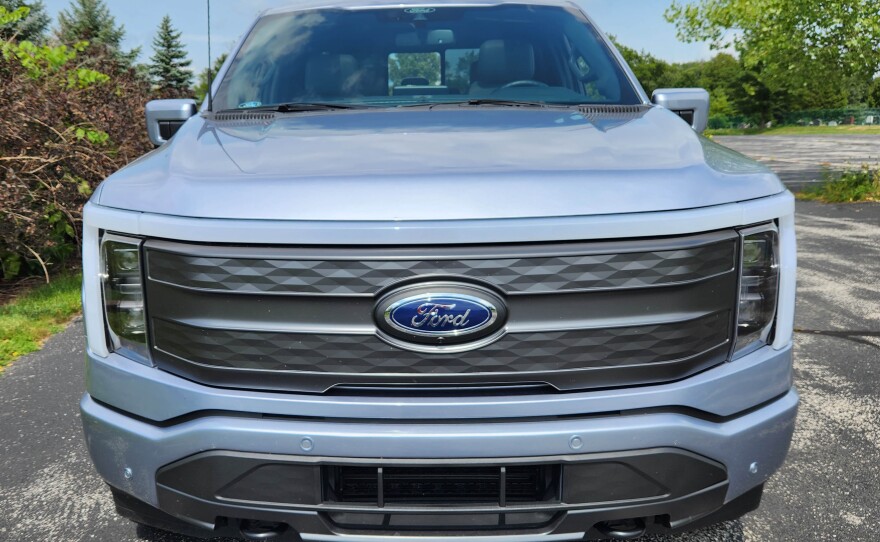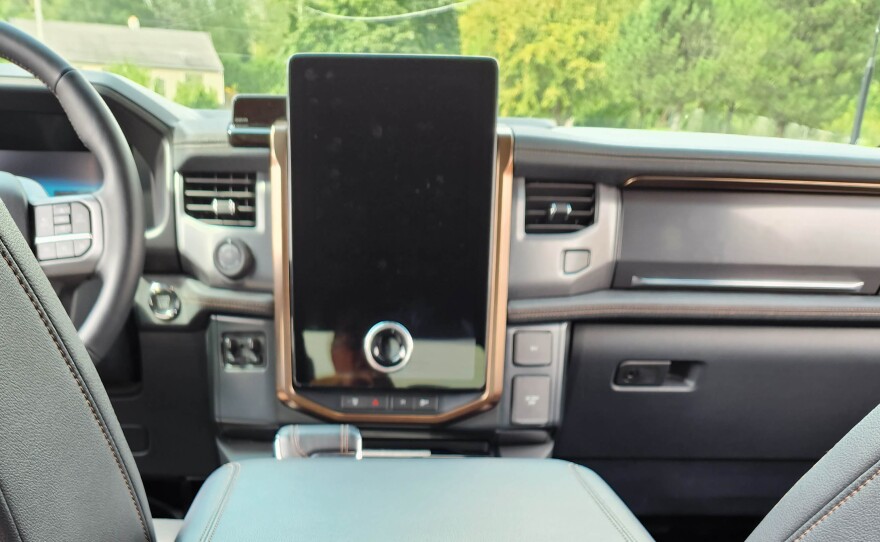One of the biggest problems any manufacturer has when their product is No. 1 in the market is coasting, resting on their laurels. Some may say resting on their behinds!
Ford could have done that anytime in the past 44 years with its F-150 pickup.
It did not, which is why Ford leads the way with the first mass-produced electric pickup, its F-150 Lightning. This debuted as a 2022 and Ford simply couldn’t build enough, and they are barely catching up with production for 2023. That’s why I received a 2022 model to review recently, but not much changed. So, I’ve provided 2023 pricing here, as that’s what is selling now, and yes, prices crept up.
More on the pricing later, let’s just say this is a luxury truck in every sense of the word.
The bright Iced Blue (light bluish silver) Lightning was the third highest trim level Lariat extended range model. That adds $9,000 to the price but includes a bevy of luxury extras.
But the big deal is the extended range battery system that boosts the normal range of 240 miles to 310 or so. I never quite got a full charge, but did see 290 miles of charge at one point at 91% charge. Note that if you put the truck in tow mode that number shrinks by about half.
Speaking of which, the Lightning is rated to pull up to 10,000 pounds, so about 2,700 less than a gas or hybrid powered model. Still, that’s a major load.
Like most electrics now with longer ranges, a fast charge (if you can find one) will boost the batteries from 15% to 80% in about 40 minutes. That takes 45 minutes for a standard battery model. If you’ve already put a 240-volt charger in your garage, a full charge takes about 10 hours with a Ford Charge Station Pro installed.
If like me, you’re stuck with the old 110-volt outlet it’ll take at least twice as long. I get about 1% of charge per hour, or about 4 miles, so a 10-hour charge nets 10% or 40 miles, in round numbers.
A side note, this is the first vehicle that was too tall to fit through my 1950’s garage’s door, so I had to run the power cord under the main door to plug in the Lightning and charge in the driveway overnight.
The test truck with standard 4-wheel-drive has two electric motors that generate 580 horsepower and a mighty torque rating of 775 pound-feet. Wow, on both.
So, Ford claims the Lightning extended range model will do 0-60 mph in 4.5 seconds and I believe it. This thing hauls tushie! That acceleration used to be what Corvette and other high-performance car owners craved and demanded.
The down low here is that there’s plenty of oomph and grunt to accelerate from a stoplight, onto a highway, or tow a major boat, or a trailer jammed with snowmobiles, no problem. You’ll just need to stop every 150 miles or so for a charge. Remember, towing cuts range significantly.
As with other F-150s, the Lightning is easy to steer and keep in its lane despite its size. Parking is less easy. Steering is fairly responsive for a truck and steering effort is moderate. Ride remains big trucky with a bit of bounce, but I’ve witnessed worse in large SUVs. Plus, the battery packs keep this 6,000+ pound truck firmly planted. High winds won’t push it about.
Inside the Lightning’s interior is all upscale luxury with thick two-tone gray leather seats and a monster 15.5-inch vertical touchscreen for map gazing and radio station cruising. It’s easy to use, as it was in the recently tested Mustang Mach-E. Again, though, it’s a bit much and overwhelming, so shrinking its height by an inch or two could make it look as if it’s designed to fit into the dash, not just appear superglued onto its face.
The seats are comfy and include brown stitching (dash and doors too) that looks sharp. The dash and door trim is gray fake wood. I’d think real wood might be more appropriate at the Lightning’s price, or at least better-looking fake stuff. Flat black graces the console to cut reflections and a thin chrome strip trims the console.
Overhead is a twin-panel panoramic sunroof with a power sunshade, something Tesla and a few other makes might want to copy. Also standard are two glove boxes and a powerful Bowers & Wilkins stereo system.
Meanwhile, the all-inclusive $9,000 extended range and high-level equipment package adds many of the niceties we all appreciate, like heated front and rear seats and a heated steering wheel, now a necessity in northern climates. This also added a power tilt-telescoping steering wheel and the truck came with power pedals to help us short-legged drivers get more comfortable.
There’s also running boards to help us crawl aboard, much needed in trucks with 8.4-inches of ground clearance, plus giant 20-inch tires and a tall door frame to boot.
Ford adds a power fold-down gear shift lever, which I originally thought gimmicky, but now see it, along with a fold-out support from the center arm rest, creates a flat area work area. That’s handy for contractors or busy executives who need to work on a laptop while seated in their luxury leather interior at a rest stop or work site. Although I don’t see this as a true work truck.
Yet is does have all the functionality of any F-150, and this has the requisite spray-in bedliner to keep the tail from scratches and rust. That’s $595 extra, but needed. And there’s a power tailgate too, which will power down and up, and lowers quietly too. A step and handle also fold out of the tailgate for easy bed access.
Back there you’ll also find a build-in generator that allows power equipment to be operated from the unit in the truck bed’s wall. And Ford tells us you also could power your house with the truck if there’s a neighborhood power outage. That might be fine for a limited time, but otherwise you’ll drain the power from the truck and may not be able to use it until power is restored to the house and the truck is recharged. A first-world quandary!
I also like the power sliding rear window that will let some air in the back, if needed. Or it could allow a longer item to be placed in the truck bed and inserted through the open window. Iffy safety but may work for a short haul.
Ford includes all the safety equipment you’d find on any luxury car or truck but adds a couple goodies you might not expect.
First is the Pro Trailer Backup Assist system that helps you hitch up to a trailer not only with the fine 360-degree screen, but controls steering, throttle and brakes to help line up and hook up a trailer to the hitch. Unfortunately, the round control is near, and similar sized to the ignition button, which can be confusing.
Then there’s BlueCruise, Ford’s hands-free semi-autonomous cruise control that allows a driver to take his or her hands off the steering wheel for a bit. It acts like any other cruise control, but has pre-programed navigation info on most US highways so it knows where the lanes twist and turn. Construction zones can through this off, though. And I found it liked me to put my hands back on the wheel about every 2-3 minutes, plus the truck liked to push hard into turns and then adjust as it exited the turns by moving back and forth in the lane for a bit.
I prefer to drive myself, but on a long straight highway (Nebraska maybe) BlueCruise could free up hands to allow you to suck down a Slurpee.
Pricing, as you may expect, is on the high end of luxury. Consider the average cost of a truck or SUV is somewhere north of $55,000 these days and the $73,685 (including delivery) starting price for the Lariat Lightning may not shock. But with the extended range battery package, a trailer package and the bedliner this one would hit $84,280 for a 2023 model. It was just more than $80 grand for 2022.
A base Lightning Pro with the 240-mile range battery system and vinyl (remember those?) seats, starts about $51,700 with delivery and the next higher XLT trim at about $55,700. Adding extended range batteries usually adds another $7k to $9k. A Platinum top-line model starts beyond $92,000, north of what my house cost about 30 years ago.
For performance and smooth quiet driving, electric can’t be beat. But for long-range hauling and budget considerations, gas or hybrid models still make a lot of sense.
FAST STATS: 2023 Ford F-150 Lightning (electric)
Hits: Roomy luxury pickup with luxury interior, wild electric power and improved range, plus a built-in generator in the bed. Huge info screen and instrument gauges, panoramic sunroof, heated wheel and front seats, power tilt/telescope wheel, power tailgate w/step, 360-degree camera, fold-down gear lever, running boards. Excellent towing power and acceleration, good handling and Pro Trailer system to help when attaching a trailer.
Misses: Big truck ride, difficult parking in tight spots, too tall for older garages, price.
Made in: Dearborn, Mich.
Engine: dual electric motors, 580 hp / 775 ft.-lbs. torque
Transmission: Single-speed automatic
Weight: 6,015 lbs.
Wheelbase: 145.4 in.
Length: 232.7 in.
Cargo bed: 52.8 cu.ft.
Tow: 10,000 lbs.
Payload: 2,235 lbs.
MPGe: 78/63
Range: 310 miles (est.)
Base Price: $73,685 (includes delivery)
Invoice: N.A.
Major Options:
Max trailer tow pkg., $1,000
Spray-in bedliner, $595
Extended range and high equipment group 511A, (BlueCruise, twin sunroof, park assist, Pro Trailer Backup Assist, heated rear seats, smart phone key compatible, power tilt/telescope steering wheel, tow technology pkg., integrated trailer brake controller, trailer reverse guidance, small trailer tow connection, rain-sensing wipers), $9,000
Test vehicle: $84,280
Sources: Ford, www.kbb.com




















